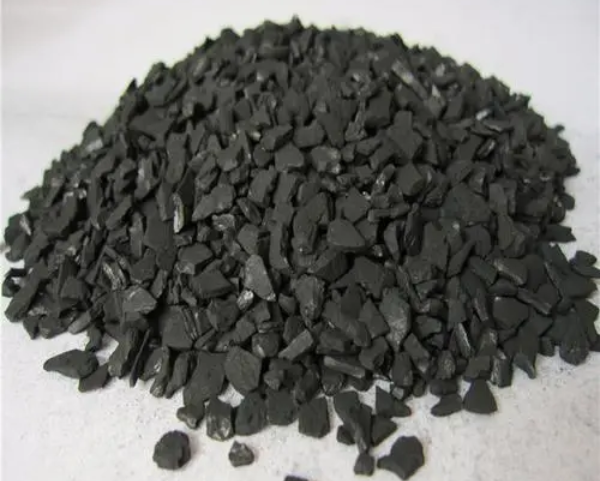Hainan Yanghang Industrial Co., Ltd.
34 years of focusing on R&D, production and sales of water treatment chemical products
 info@hnyhxd.com
info@hnyhxd.com
Production Method And Process Of Activated Carbon
Activated carbon is a kind of specially treated carbon, in which organic raw materials (fruit shells, coal, wood, etc.) are heated under air-isolated conditions to reduce the non-carbon components (a process known as carbonisation), and then reacted with gases, the surface of which is eroded to produce a microporous and well-developed structure (a process known as activation). Since the activation process is a microscopic process, i.e. the surface erosion of a large number of molecular carbons is point erosion, the result is an activated carbon surface with countless tiny pores. Most of the micropores on the surface of activated carbon have a diameter of between 2 and 50 nm, and even a small amount of activated carbon has a huge surface area of 500 to 1500 m2 per gram of activated carbon, and almost all applications of activated carbon are based on this feature of activated carbon.

Introduction to the preparation method of activated carbon
1. Raw materials
Almost all carbon-containing materials can be used to make activated carbon. For example, cellulose-containing materials such as wood, sawdust, peat, and rice straw are usually treated only by chemical activation. There are dabbling tests using rice straw and cornstalks, and activated carbon has also been made from soya bean dregs by activation with potassium carbonate as a raw material.
2. Activation
The key process for manufacturing activated carbon is activation. Due to the different activators used, it can be divided into two types of methods:
(1) Chemical activation method using chemicals such as zinc chloride or phosphoric acid as activators;
(2) Gas activation method using water vapour or carbon dioxide as the activator.
The former is called chemical activation and the latter is called physical activation. In fact, the two types of activation processes are their own livelihood qualitative changes, are the process of chemical changes.
3. Chemical activation method
(i) Zinc chloride activation method
The chemical zinc chloride is used as the activator.
Will be 0.1-0.5 parts of zinc chloride concentrated solution and 1 part of peat or sawdust mix, dry in the converter, heated to 600-700 ℃, the finished product to pickling and washing to recover zinc salts. Sometimes chemical activation is followed by water vapour activation to increase the number of pores.
Zinc chloride activated activated carbon has more large also. Although this is an effective and simple method, but because of the environmental pollution of zinc compounds compounds and decline.
(ii) Phosphoric acid activation method
The chemical phosphoric acid is used as an activator.
Charred or uncharred carbon-containing materials are used as starting materials. For example, finely ground sawdust and phosphoric acid are mixed into a slurry, dried in a converter and heated to 100-600°C. The slurry is extracted to recover phosphoric acid, which is sometimes neutralised. Phosphoric acid is recovered by extraction and sometimes phosphate is recovered by neutralisation. Drying results in activated carbon, which generally has finer pores than that of zinc chloride.
Combined activation with phosphoric acid and water vapour can also be used. In recent years, phosphoric acid activation method tends to be commonly used, phosphoric acid recovery and other innovations have not been published.
(iii) Potassium hydroxide activation method
With the chemical potassium hydroxide as an activator.
The carbon-containing raw materials are treated with molten anhydrous potassium hydroxide, and the intense reaction produces very high porosity, with a specific surface area of up to 3000 m2/g.
(iv) Other chemicals activation method
Sulphuric acid, potassium sulphide, aluminium chloride, ammonium chloride, borates, boric acid, calcium chloride, calcium hydroxide, chlorine gas, hydrogen chloride, iron salts, nickel salts, nitric acid, nitrous gas, diphosphorus trioxide, potassium metal, potassium permanganate, metallic sodium, sodium oxide and sulphur dioxide can be used for activation.
4. Gas activation method
Water vapour, carbon dioxide or a mixture of the two gases as an activator, will contain carbon materials and gases in the converter or boiling furnace, at a high temperature of 800-1000 ℃ for carbon oxidation reaction, made of activated carbon with a developed pore structure.
The reaction of water vapour, carbon dioxide and carbon is a heat-absorbing reaction, while the reaction of oxygen and carbon is a strong exothermic reaction, so it is difficult to control the temperature of the reaction in the furnace, especially to avoid local overheating, and it is even more difficult to prevent non-uniform activation, so oxygen or air is not suitable to be used as an activator. Sometimes a mixture of air and water vapour is used, and the combustion of carbon is used as the heat source. In most cases, a mixture of flue gas and water vapour is used, as a small amount of chlorine will inevitably be mixed, resulting in water vapour, carbon dioxide and oxygen three gases involved in the activation at the same time.
Production process of activated carbon
1. Preparation of raw materials
Firstly, the raw materials need to be cleaned, screened and crushed to remove impurities and control the particle size. For hard raw materials such as wood, they need to go through the process of high temperature steaming and carbonisation to convert them into carbonaceous materials and remove water and impurities at the same time.
2. Chemical activation of activated carbon
Carbonaceous-based materials are put into a reactor, chemical activators (generally phosphoric acid and potassium acid) are added, and the reaction is carried out under high-temperature conditions to generate activated carbon benchmarks with large pore sizes and mesopore sizes. The reaction between the chemical activator and the carbon in this process continues for hours to tens of hours until the end point of the reaction is reached.
3. Temperature treatment and washing
The manufactured activated carbon is placed in a high temperature oven to reach a temperature of over 800°C to obtain a certain degree of hardness and stability, and at the same time to eliminate impurities and chemical activators left over from the reaction process. Then it enters the water washing stage, which is used to remove the impurities attached to the surface to ensure the quality and adsorption performance of the activated carbon.
4. Drying and sieving
After the water washing process, the activated carbon needs to be dried to remove water and remaining impurities. The activated carbon is then sorted and packaged according to different particle sizes through a sieving process.
The process of making activated carbon requires several steps and complex machinery and equipment, but it is the only way to create good quality activated carbon.
Activated carbon has a wide range of application prospects in environmental protection, air purification, medical and health care, food industry, water treatment, etc. Therefore, the technology and research of activated carbon production will be a hot field and make greater contribution to the environmental protection cause. Hainan Yanghang, as one of the activated carbon manufacturers in Hainan, has professional technology, if you need, welcome to consult.

